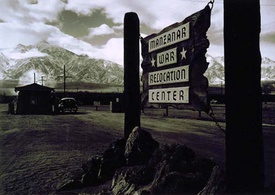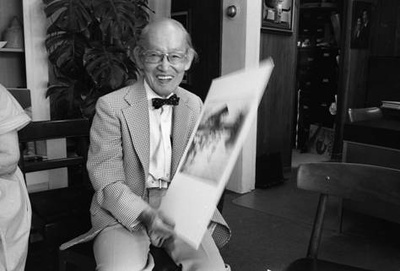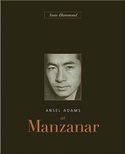Read Part 15 >>
The Post-War Years: Coming to Terms with Manzanar
Of course once freed from the concentration camps, the Japanese did congregate in clusters, many settling not far from the Los Angeles Little Tokyo they had inhabited before the war. Decades of pre-war racial prejudice followed by the mass illegal roundup and imprisonment had encouraged a clannishness, as well as complicated feelings of discomfort, shame and anger in relation to non-Japanese. Patrick Nagatani’s account of the 1977 UCLA photography show he co-curated with Graham Howe and Scott Rankin, “Two Views of Manzanar,” offers insight into some of these feelings.
The first exhibit of Manzanar photographs to recognize Miyatake outside the Asian-American community, the show was held at the Frederick S. Wight Gallery on the UCLA campus. It became “an interesting bridge,” says Nagatani, between the insular Los Angeles Japanese community and the white, outside world. “Archie was suspicious of us from the beginning,” Nagatani recalls and ironically seemed to prefer dealing with Nagatani’s fellow fine arts graduate student, “the sweet-talking Graham Howe, with his Australian accent.” Howe became the liaison to the Japanese community. The Nisei were wary of one of their own (for leaving the Japanese fold), reflexively deferential to a non-Japanese outsider (their wartime experience had taught them not to make waves for fear of reprisal), and unwilling to leave their geographical comfort zone to see an exhibit that would dredge up memories of “camp.”

Toyo Miyatake with son Archie, and other family members in background. At right, standing, is “Two Views of Manzanar” co-curator Patrick Nagatani. Photograph by Graham Howe, 1977. (Photo courtesy of Graham Howe)
The situation was very different when later, Nagatani staged another art show at the Japanese Community Center in Little Tokyo featuring five artists’ work on the concentration camps. The community turned out in force to view it, says Nagatani, “because it was in J-town, because it was held in a venue that Japanese were comfortable with, especially the Nisei.”
In an interview with Adams scholar Anne Hammond posted on the Japanese American National Museum website, Exploring the Legacy of Ansel Adams at Manzanar, Hammond hinted at the Nisei’s deep, unexpressed reserve of emotions about the prison camps:
“In Hawaii, the audience seemed genuinely amazed that Adams pursued this project under the difficult conditions of the time,” says Hammond. “They were shocked at the story of the internment itself, and happy to know that a photographer they had previously thought of merely as an artist of the ‘grand western landscape’ had made the moral choice to try to influence public opinion about it. In Los Angeles, of course, where so many of the audience had been incarcerated either at Manzanar or one of the other camps, the reception was much more subdued. I think people there, although admiring Adams’s positive motivations, saw the photographs as confirmations of the determination that such an infringement of liberty should never happen again.”

Unencumbered by the anger and shame of the prisoners, Adams set out to capture the social injustice inherent in the Manzanar prison camp. Photograph by Ansel Adams. (Source: Library of Congress Prints and Photographs Division Washington, D.C. 20540 USA.)
Perhaps some of these Nisei were like my Uncle George, who had during their imprisonment and in the years immediately following, tried hard to prove their loyalty, work hard, and blend in, then, after the successful redress movement of the ’70s and ’80s, gradually come around to acknowledging the injustice that had been done to them.
This comment from the book that accompanied the 1977 UCLA exhibit, “Two Views of Manzanar,” alludes to the difference between the inmate photographer’s reflexive, more muted, reaction to his sudden imprisonment and the moral outrage (however carefully expressed) of the free white photographer: “While Miyatake the prisoner was seized by the desire to document the camp, Adams was “motivated more by a sense of social injustice.” Adams, the apolitical white nature photographer, had the luxury of exhibiting a keen sense of injustice while Miyatake, the Japanese prisoner, had to place at a remove what must have been overpowering feelings of shame, hurt and anger over the interruption of his life, career and artistic pursuits. He was luckier than most to have a calling: His photography served as a channel for expressing these emotions while bearing witness with his camera.

A smiling Toyo Miyatake at the Toyo Miyatake Studio in Little Tokyo in 1977. Photograph by Graham Howe. (Photo courtesy of Graham Howe)
© 2011 Nancy Matsumoto






